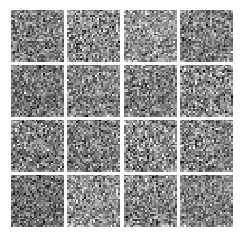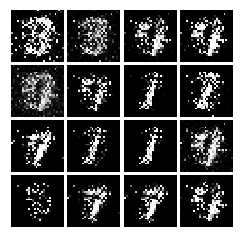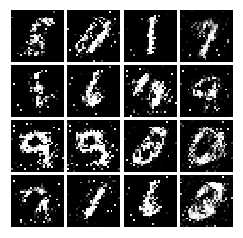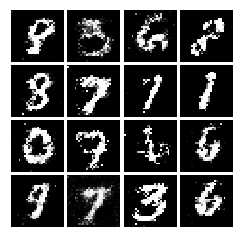标签:inpu def HERE Dimension max and vat pool ann
def leaky_relu(x, alpha=0.01):
"""Compute the leaky ReLU activation function.
Inputs:
- x: TensorFlow Tensor with arbitrary shape
- alpha: leak parameter for leaky ReLU
Returns:
TensorFlow Tensor with the same shape as x
"""
# TODO: implement leaky ReLU
condition = tf.less(x,0)
res = tf.where(condition,alpha * x,x)
return res
def sample_noise(batch_size, dim):
"""Generate random uniform noise from -1 to 1.
Inputs:
- batch_size: integer giving the batch size of noise to generate
- dim: integer giving the dimension of the the noise to generate
Returns:
TensorFlow Tensor containing uniform noise in [-1, 1] with shape [batch_size, dim]
"""
# TODO: sample and return noise
return tf.random_uniform([batch_size,dim],minval = -1,maxval = 1)
Architecture:
def discriminator(x):
"""Compute discriminator score for a batch of input images.
Inputs:
- x: TensorFlow Tensor of flattened input images, shape [batch_size, 784]
Returns:
TensorFlow Tensor with shape [batch_size, 1], containing the score
for an image being real for each input image.
"""
with tf.variable_scope("discriminator"):
# TODO: implement architecture
fc1 = tf.layers.dense(x,256,use_bias = True,name = ‘fc1‘)
leaky_relu1 = leaky_relu(fc1,alpha = 0.01)
fc2 = tf.layers.dense(leaky_relu1,256,use_bias = True,name = ‘fc2‘)
leaky_relu2 = leaky_relu(fc2,alpha = 0.01)
logits = tf.layers.dense(leaky_relu2,1,name = ‘fc3‘)
return logitsArchitecture:
ReLUReLUTanH (To restrict every element of the output to be in the range [-1,1])def generator(z):
"""Generate images from a random noise vector.
Inputs:
- z: TensorFlow Tensor of random noise with shape [batch_size, noise_dim]
Returns:
TensorFlow Tensor of generated images, with shape [batch_size, 784].
"""
with tf.variable_scope("generator"):
# TODO: implement architecture
fc1 = tf.layers.dense(z,1024,use_bias = True,activation = tf.nn.relu)
fc2 = tf.layers.dense(fc1,1024,use_bias = True,activation = tf.nn.relu)
img = tf.layers.dense(fc2,784,use_bias = True,activation = tf.nn.tanh)
return imgdef gan_loss(logits_real, logits_fake):
"""Compute the GAN loss.
Inputs:
- logits_real: Tensor, shape [batch_size, 1], output of discriminator
Unnormalized score that the image is real for each real image
- logits_fake: Tensor, shape[batch_size, 1], output of discriminator
Unnormalized score that the image is real for each fake image
Returns:
- D_loss: discriminator loss scalar
- G_loss: generator loss scalar
HINT: for the discriminator loss, you‘ll want to do the averaging separately for
its two components, and then add them together (instead of averaging once at the very end).
"""
# TODO: compute D_loss and G_loss
loss1 = tf.nn.sigmoid_cross_entropy_with_logits(labels = tf.ones_like(logits_real),logits = logits_real,name = ‘discriminator_real_loss‘)
loss2 = tf.nn.sigmoid_cross_entropy_with_logits(labels = tf.zeros_like(logits_fake),logits = logits_fake,name = ‘discriminator_fake_loss‘)
loss3 = tf.nn.sigmoid_cross_entropy_with_logits(labels = tf.ones_like(logits_fake),logits = logits_fake,name = ‘generator_loss‘)
D_loss = tf.reduce_mean(loss1 + loss2)
G_loss = tf.reduce_mean(loss3)
return D_loss, G_loss# TODO: create an AdamOptimizer for D_solver and G_solver
def get_solvers(learning_rate=1e-3, beta1=0.5):
"""Create solvers for GAN training.
Inputs:
- learning_rate: learning rate to use for both solvers
- beta1: beta1 parameter for both solvers (first moment decay)
Returns:
- D_solver: instance of tf.train.AdamOptimizer with correct learning_rate and beta1
- G_solver: instance of tf.train.AdamOptimizer with correct learning_rate and beta1
"""
D_solver = tf.train.AdamOptimizer(learning_rate = learning_rate,beta1 = beta1)
G_solver = tf.train.AdamOptimizer(learning_rate = learning_rate,beta1 = beta1)
return D_solver, G_solverdef lsgan_loss(scores_real, scores_fake):
"""Compute the Least Squares GAN loss.
Inputs:
- scores_real: Tensor, shape [batch_size, 1], output of discriminator
The score for each real image
- scores_fake: Tensor, shape[batch_size, 1], output of discriminator
The score for each fake image
Returns:
- D_loss: discriminator loss scalar
- G_loss: generator loss scalar
"""
# TODO: compute D_loss and G_loss
D_loss = 0.5 * tf.reduce_mean(tf.square(scores_real - 1)) + 0.5 * tf.reduce_mean(tf.square(scores_fake))
G_loss = 0.5 * tf.reduce_mean(tf.square(scores_fake - 1))
return D_loss, G_lossArchitecture:
def discriminator(x):
"""Compute discriminator score for a batch of input images.
Inputs:
- x: TensorFlow Tensor of flattened input images, shape [batch_size, 784]
Returns:
TensorFlow Tensor with shape [batch_size, 1], containing the score
for an image being real for each input image.
"""
x = tf.reshape(x,shape = (tf.shape(x)[0],28,28,1))
with tf.variable_scope("discriminator"):
# TODO: implement architecture
conv1 = tf.layers.conv2d(x,filters = 32,kernel_size = (5,5),strides = (1,1),activation = leaky_relu)
max_pool1 = tf.layers.max_pooling2d(conv1,pool_size = (2,2),strides = (2,2))
conv2 = tf.layers.conv2d(max_pool1,filters = 64,kernel_size = (5,5),strides = (1,1),activation = leaky_relu)
max_pool2 = tf.layers.max_pooling2d(conv2,pool_size = (2,2),strides = (2,2))
flat = tf.contrib.layers.flatten(max_pool2)
fc1 = tf.layers.dense(flat,4*4*64,activation = leaky_relu)
logits = tf.layers.dense(fc1,1)
return logits
test_discriminator(1102721)Architecture:
ReLUReLUReLUTanHdef generator(z):
"""Generate images from a random noise vector.
Inputs:
- z: TensorFlow Tensor of random noise with shape [batch_size, noise_dim]
Returns:
TensorFlow Tensor of generated images, with shape [batch_size, 784].
"""
batch_size = tf.shape(z)[0]
with tf.variable_scope("generator"):
# TODO: implement architecture
fc1 = tf.layers.dense(z,1024,activation = tf.nn.relu,use_bias = True)
bn1 = tf.layers.batch_normalization(fc1,training = True)
fc2 = tf.layers.dense(bn1,7*7*128,activation = tf.nn.relu,use_bias = True)
bn2 = tf.layers.batch_normalization(fc2,training = True)
resize = tf.reshape(bn2,shape = (-1,7,7,128))
filter_conv1 = tf.get_variable(‘deconv1‘,[4,4,64,128]) # [height, width, output_channels, in_channels]
conv_tr1 = tf.nn.conv2d_transpose(resize,filter = filter_conv1,output_shape = [batch_size,14,14,64],strides = [1,2,2,1])
bias1 = tf.get_variable(‘deconv1_bias‘,[64])
conv_tr1 += bias1
relu_conv_tr1 = tf.nn.relu(conv_tr1)
bn3 = tf.layers.batch_normalization(relu_conv_tr1,training = True)
filter_conv2 = tf.get_variable(‘deconv2‘,[4,4,1,64])
conv_tr2 = tf.nn.conv2d_transpose(bn3,filter = filter_conv2,output_shape = [batch_size,28,28,1],strides = [1,2,2,1])
bias2 = tf.get_variable(‘deconv2_bias‘,[1])
conv_tr2 += bias2
img = tf.nn.tanh(conv_tr2)
img = tf.contrib.layers.flatten(img)
return img
test_generator(6595521)
Epoch: 0, D: 0.2112, G:0.3559
Epoch: 1, D: 0.196, G:0.2681

Epoch: 2, D: 0.1689, G:0.2728
Epoch: 3, D: 0.1618, G:0.2215

Epoch: 4, D: 0.1968, G:0.2461
Epoch: 5, D: 0.1968, G:0.2429

Epoch: 6, D: 0.2316, G:0.1997
Epoch: 7, D: 0.2206, G:0.1858

Epoch: 8, D: 0.2131, G:0.1815
Epoch: 9, D: 0.2345, G:0.1732
Final images

CS231n assignment3 Q5 Generative Adversarial Networks
标签:inpu def HERE Dimension max and vat pool ann
原文地址:https://www.cnblogs.com/bernieloveslife/p/10224687.html